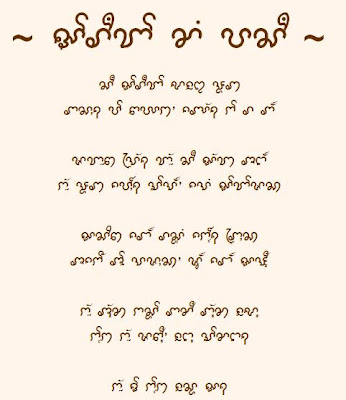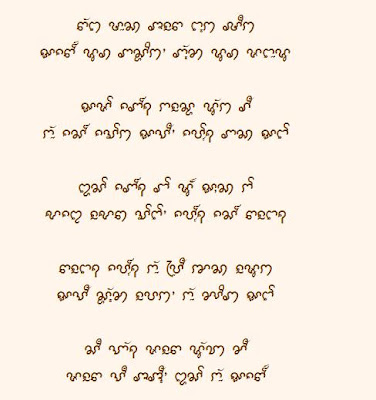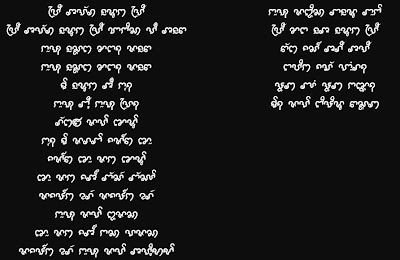naiKacua mai mâng Rajaka Campa.. Daok mani klak puk paga oh mada.. Ranem ngan srem mâgru sap inâ ita.. Paraong ndei agal drei takik urang caik mata.. Salam saong ndua apakar raweng blok dahlak. naiKacua birau magru, puec pataow wek hai nyâ! ^_^
Tuesday, December 22, 2009
:: I'm Wondering...
Monday, December 21, 2009
:: Wahai Taong Abih Urang Islam
Ikhwan-ikhwan kung Islam
Taong (a)bih (a)pan gam
Taong (a)bih.. taong (a)bih sahabat
Peng waik nasihat saong jier di hatai
Brei srem mâgru hai ka hukum Po drei
Kung Po Nyu brei hu drei jieng Islam
Kung Po (a)nit ranam di Palei A-khirat
Kung ndail rup drei
Brei rumiak.. brei rumiak pa-ndi biniai
Brei khria ngap (a)mal
Ngap (a)mal.. ngap (a)mal siam makrâ
Tuei jalan Po pandar
Tuei jalan Po pagop
Khria ngap paginaop
Khria ngap waik panjep
Dom-dom danak dak sunat dan phardu
Khria srem mâgru hai paca-mbas padeng gruk
Juai nah drei mâk ta hu haong mblah tuei gep
(Mâ)yah lac.. (mâ)yah lac ngap njep
(Mâ)yah lac ngap njep hu pahala Po brei
Brei (ha)der waik drei.. brei (ha)der waik drei yakin di hatai
Kung ndail calah matai..kung ndail calah matai
O waik hi klah kung suei kung drah
Rel-rel mada nyawa
Klah o mersa maot nyu..maot nyu mâk nyawa
Nyu mâk haong senang senia
Mângaok (u)rang.. mângaok (u)rang kung mada iman
Nyu mâk haong kan daman mângaok (u)rang kung mada (ha)duissa
Kung ma-in sa-mbai suka brei caga hai waik drei
Tel nao harei (ha)dei labik Po jumrah
Thursday, December 17, 2009
:: Harei Pagé Raya Patrah
~Harei Pagé Raya Patrah~
Harei pagé Raya Patrah
Drei anâk Cam
Kabak lakau ma-aph (a)maik (a)mâ
Brei drei kanal nao waik
Haong (a)maik (a)mâ
Drei (ha)duissa lo lo
Di klak juai semyang
Brei srem mâgru
Brei thau lo (ha)duissa
(U)rang (ha)lei nao ma-aph o
Po binasa
Mada o hu harei siam
“Mba” drei khin siam makrâ
Drei jeng anâk
Mada lac jaik (a)tah o
Brei drei nao nyu hu
Nao lakau ma-aph
Huec Po brei drei siam
Drei nao ma-aph (a)maik (a)mâ
Huec hu siam
Nao jalan akhirat
Ginaop rup umat di klak juai
Nao lakau ma-aph (a)maik (a)mâ
Well...I'm not used to write in Akhar Thrah, plus, I'm confuse with the "balau", the "Mâk" and "Mak".."S1" "S2"..and many more..urrgghhh!! ..So..I did a lot of mistakes....ermm..but..I hd corrected it..then..I put the correct one as a new presentation, which you can see in the pictures above..I hv no mood to edit the video............ Tell me if the correction is still incorrect, thank U. [Arggghh, tension aku!]
This song is cute, and simple. I like it. I want to state my very appreciation to radiosapcham.com for ..errkk..for many reasons. I have no idea to write anything rite now..my head stucked! Hhhellpp!
Tuesday, December 15, 2009
:: Ikak Tian Ka Anâk Nao Bac
This song is specially dedicated to my mom and dad, also an alert to my younger brother.
Adei ley, peng baik sa-ai ndom ni..
Adei nao bac klak sang klak palei..
Kayua nan inâ imâ ciip rambah rambi..
Juai wer apakar inâ saong imâ juai adei..
Bac bitanat hadei hu phuel ka paran drei..
Adei hadah mbaok inâ imâ jang buei rei..
Sunday, December 13, 2009
:: Raksa Rasam Cam
Islam ugama bangsa Cam drei
Daok ngap rel harei
Lakei kamei di Palei Kemboja
Ndih sanâng harei malam
Haong sambai senang senia
Hu oh ndail mada
Ugama di klak oh rei
Hukum sah batal halal haram
Taong (a)bih drei Cam
Rel malam ndail klak oh wer
Mbâng huak chung njep
Kayua rup drei thau
Ngap chung drei (ha)der
Lakau ma-aph brei drei siam makrâ
Hukum ngaok kamei
Rel harei tacei pataow
Pambeng huak anâk tacaow
Pamâgru ilimo bac da-a
Chamnék pasang lakei
Rel harei pataow pa(ha)der
Kabak nao duah mbeng
Raong ba anâk tacaow grusa
Khan pataik aw (a)tah
Tambak kama gaom (a)kaok
Cam Kraong Cam Ngaok
Hukum yang sempurna
Lakhah anâk lakhah tacaow
Tuei jalan ugama
Yang sambai suka
I want to explain the words I’m not following the lyrics given:
1) Rel harei – if we read the old Cam scripts it is “rim harei” but nowadays we used to use “rel harei”. This word is used by the Angiang-PaleiKur Cams…haha..it is actually a Cambodian word. So now, try to start using that “rim harei” ok.. =). I kept the word “rel harei” while editing because it had been a Cam word (borrowed of course).
2) Kampujia – it should be in Malay spelling actually, because if U write in English it will be “Cambodia” while in Khmer Language it is “Khmer”, in Cam Language it is “Kur”. So, that “Kampujia” is a Malay word PRONOUNCED by the Cams. That is why I wrote “Kemboja” in Akhar Thrah.
3) “Haong” is correspond to “saong”, many of the Angiang-PaleiKur pronounce “haong”, so I kept that word because it is not a mistake.
4) “Senang senia” – I dun know whether our siblings in Ninh Thuan will understand these words. They are Cam words, the Malays have the same word; “senang” which means “comfort”. Or..we borrowed the word..? I hv no idea.
5) Chung – Cambodian word, refer to Aymonier Dict. pg 138.
6) Maaf – I spelled “maaph” because I dun see the letter “F” in Cam language! Hihihi..
7) Chamnek – this is totally in Cambodian language, I can’t find it in the dictionary, and I never used this word for the rest of my life. Meaning that, I’m a girl who was born in Vietnam and never been to Cambodia, so I never heard it. Malay: pihak, English: party (in group impression, not birthday party!)
8) Gruasa – I dun use this word, but I understand it. I think it is pronounced “grusa” that is why I didn’t use “takai kuak” in Akhar Thrah. Cam: mangawom, Malay: keluarga, English: family.
9) Samfarna – Malay word, “sempurna” actually.
10) “Sabhai” – “sambai”, Cambodian word. Cam: cheh, English: happy
10) Suka – Malay word. I thought this is Cam word before… Cam: takrâ…sambai suka = cheh chai… Wht about “buei baiy” ..???
Tuesday, November 17, 2009
:: Studying Literature - Ariya Cam Bani






















- ELEMENTS OF THE ARIYA -
Speaker/ Persona
It seemed to be a dialogue between a guy and a girl.
Guy: “Mayut dreh yau ni aey haleng”. Haleng is girl darling.
Setting
(1) Background Setting
:: The girl’s house – “Sang suer mariah siam ndei”
:: The guy’s bedroom – “Tamâ tel duk cei ndih”
:: A path in a bush – “Rimaong daok pagrang di krâh jalan”
:: A tree – “Ala phun hara tattey rambah”
:: A forest (?) – “Ka than kau rimbah mai daok di glai”
(2) Time Setting
:: Night – “Malam ndih sa tuk min wer”
:: Afternoon – “Amâ amaik patey kau di pandiak”
Themes
:: Love and Passion between both guy and girl is the main theme.
:: Sacrifice is another theme. The girl was willing to abandon her family and against the tradition for her beloved guy.
Motif
:: Love
:: Craze
:: Enthusiasm
:: Belief and tradition
Tone & Mood
:: Sad and gloomy.
Structure & Style
:: This ariya is a symbolic poem.
:: Rhyme scheme:
(1) ab, bc, cd, de, ef....
Ni ariya sa-ai ngap (a)
Panâh ba tabiak, piéh ka ra peng,, (b)
Mayut dreh yau ni aey haleng (c)
Kau ngap blaoh padeng, dom ayamân,, (d)
Anit saong ranam klaoh prân (e)
Haké hu damân mbeng saong anguei,, (f)
Kau huec kanda pacei puec suei (g)
Klak kau matuei luai pacalah,, (h)
Kau o klak nai ah (i)
Kau huec calah yua amaik amâ,, (j)
Haley tian kau praong lo ka hâ (k)
Amaik saong amâ kau ndua sa gah (l)
(2) Parallelism (?)
Ni ariya sa-ai ngap,
Panâh ba tabiak piéh ka ra peng,,
Mayut dreh yau ni aey haleng,
Kau ngap blaoh padeng dom ayamân,,
:: Poetic Devices:
(1) Antagonist characteristic showed by the girl’s family.
“Inâ pacalah kau di pacei"
(2) Dialogue
“Cei ley kau biai yau ni baik ah, than drei rambah o bik payau” – She talked to him.
“Adei ley amaik amâ ké thau, kau ciip ndua maluw gep gan ra klao” – He talked to her.
(3) Monologue
“Aey juk gila o dreh yau urang”
(4) Hyperbole
“Raiy rup dahlak yaom ndae candiéng”
(5) Object Imagery – ciéw, kajang, ba-ar, hahuei; Color Imagery – Mâriah.
(6) Anthropomorphism
“Tamia di mblang sa drei pabaiy”
(7) Metaphor
“Huak oh tamâ ndih jang oh wer”
(8) Foreshadow
“Mâyah lac mâtai, ndih sa lubang”
(9) Simile
“Pajaih nai pajaih ciim heng”
(10) Repetition
“Anit saong ranam praong lo, likau dher di Po taom sa anih” ... “Anit saong ranam praong lo, likau dhar di Po drep o salih”
(11) Symbolism
“Sang suer inâgaray kaong dar” – Huge house symbolizes wealth and riches.
(12) Assonance
“Cakaong baong kanai ba nao” …”amaik amâ batuk éw mai tanyi”
(13) Alliteration
“Dahlak daok gandeng blaoh lua tamâ” …”sa-ai sait paga blaoh nao talaih”
(14) Anaphora
“Cuh aem kanai biak ligaih"…“Cuh aem amaik amâ o laow” …”Cuh aem kanai biak ndang”
(15) Responsi
* Dahlak copy mângaok copy min ariya ni..biak dahlak hawing saong hadom abaoh panuec dalam ni wak oh sa jalan wak. Pagep : “ra”, “hâ”, “o” wak saong “balau” ngan oh hu “balau”...”ranem” ngan “dher”...mâda kanain wak hu “paoh thek”, kanain krei wek oh hu. Akhar “Mâk” “Mak” ngan..“rambah” “rimbah”....?








